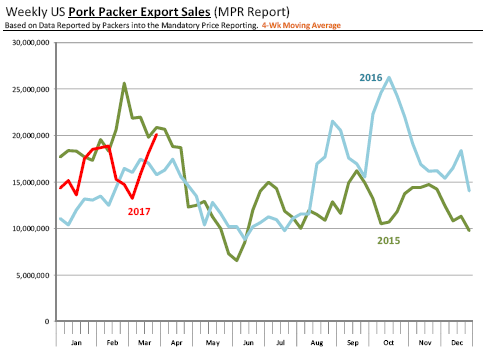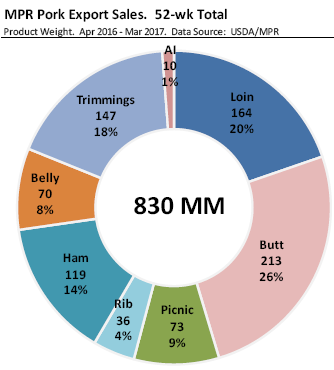



CME: Revision of US Pork Production Projections Expected
US - The last USDA WASDE report projected 2017 US pork production at 26.121 billion pounds, 1.2 billion pounds (+4.7 per cent) more than a year ago and 1.6 billion pounds (+6.5 per cent) more than in 2015, according to Steiner Consulting Group, DLR Division, Inc.This projection was made before the release of the 1 March Hogs and Pigs inventory numbers and we suspect USDA will revise up (modestly) its earlier projections. Any way you look at it, the supply increase in the pork complex this year will be quite significant and robust export demand will be critical in helping absorb the supply increase.
In its latest supply/demand balance sheet, USDA analysts allocated the distribution of the additional 1.2 billion pounds as follows: about 40 per cent of it would be absorbed by export markets (+8.3 per cent increase in exports), about 40 per cent would be absorbed by US consumers (+1.4 per cent increase in per capita consumption) and the rest will either offset the reduction in pork imports or be carried over into the following year.
Indeed, USDA in its last report projected pork ending stocks for 2017 to be 635 million pounds, 128 million pounds (+25 per cent) higher than the previous year.
There is relatively good visibility of the US pork trade flows but sometimes it is difficult to really gauge that flow in real time. Some pieces of data are quite timely but they only show you information about a portion of the market and so are hard to generalize. Others are more comprehensive but lack in granularity (no info on specific cuts) and are reported with significant time lags (a month or more).
One of the more timely pieces of information about US exports comes from the Mandatory Price Reporting system. Packers are required to report to USDA not just pork sales for the next couple of weeks but also pork that has been sold for future delivery (forward sales), pork that has been sold using some sort of formula and pork that has been sold into export markets. This last one is interesting as it gives us visibility not just on the supply of pork sold but also the price of that product and the kind of pork products going into exports.
But, and here comes the caveat, it is important to recognize that the pork export numbers from the Mandatory Report System only capture a small subset of all US pork going to export. The reason has to do with who is covered by the MPR law. Major packers have to submit this information and they do. But there is a large number of processors, exporters and other such entities that purchase product from packers and then either trade it into export markets outright or process so it meets export specifications and then sell it.
Based on the latest MPR data, export volume of pork cuts (this is net variety products) was 830 million pounds. Even if we convert this to a carcass weight basis using a 1.3 conversion, we still come up with just a little over 1 billion pounds of pork products compared to the +5 billion pounds of pork that we export annually.
The chart below shows the weekly export sales for the last 3 years based on the MPR data and the shape is similar to what we see with overall exports. Note the big spike in exports last fall as very low prices allowed packers to book some big export packages.


The mix of products reported by the Mandatory Price Reporting system is quite interesting. In the last 52 weeks, the most popular product sold by packers into export channels were pork butts (pork shoulder). Most of the pork butts sold are either bnls vac pack frozen butts or CT butts. Often the premiums for product going to export are quite significant, with the latest report showing export CT butts at $2.08 while product sold in domestic market at $1.62. You can see the full detail on export sales and the corresponding prices by clicking here.








